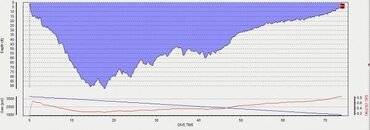Here's an interesting kink. From a dive log of mine (from an air integrated computer, regular air) showing the depth profile and varying sac rate, it appears that SAC (red line in pic) may be a function of depth (purplish area). Moreover, SAC rate improves as I go deeper. I've checked about my past 100 logs with this computer, and they invariably follow this pattern. And I don't think this is explained by differences in activity level at different depths, as I don't think I'm much less active deep down on the wall than at its upper levels.
Has anyone else noticed this? While of course total air burned will increase as depth increases, it will not be linear. In other words, calculating gas consumption by multiplying SAC rate by ATM may not be accurate. I would sure love it if anyone else would chime in on this with their data. I know it's a bit of a tangent, but we could always put it in its own thread if the OP isn't interested.
View attachment 98531





